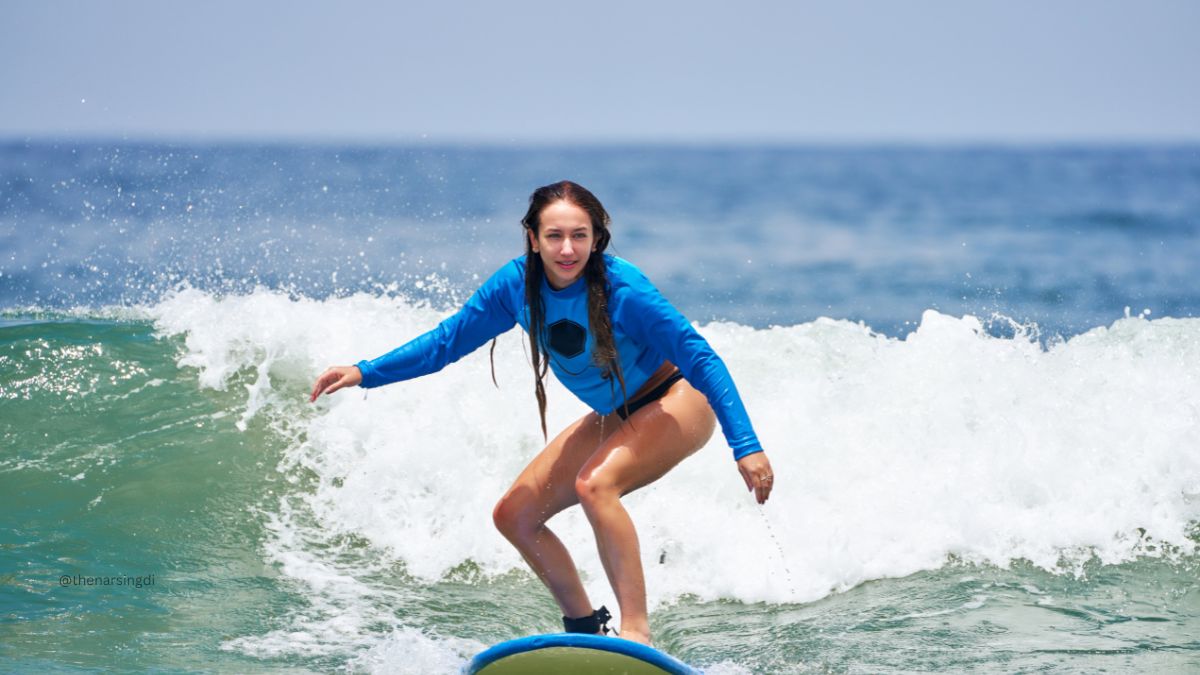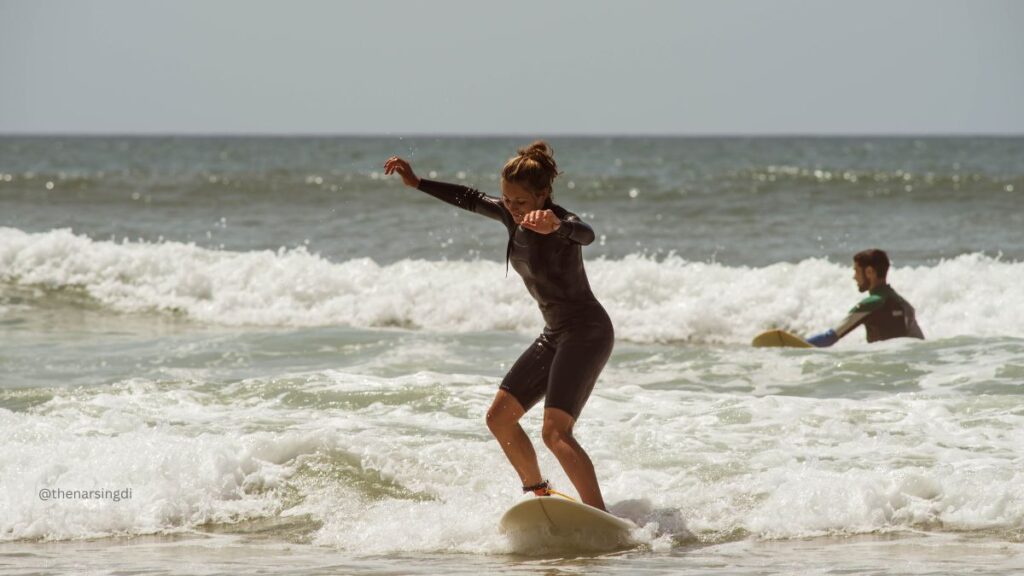How to surf for the first time? Taking on the challenge of surfing for the first time is an exhilarating adventure that blends excitement with a touch of nervousness.
The moment you ride your first wave is unforgettable, but it takes a bit of know-how to reach that point. Whether you’re answering the ocean’s call or simply eager to try something new, this guide is your starting point.
We’ll walk you through the essentials, from picking the right gear to grasping the basics of wave riding.

How To Surf For The First Time:
TOC
Experiencing surfing for the first time is an exhilarating blend of excitement, challenge, and the sheer joy of riding the ocean’s waves. If you’re stepping into the world of surfing, here’s a guide how to surf for the first time out on the water.
1. Equip Yourself with the Right Gear
Prior to jumping into the waves, having the proper gear is essential. As a beginner, a long, soft-top surfboard is your best bet, offering stability and ease when catching waves. Don’t forget a wetsuit, especially in cooler climates, to keep you comfortable. A leash to secure your board and surf wax for better grip are also essentials to have.
2. Prioritize Ocean Safety
Safety is key when surfing. Start by selecting a surf spot with gentle, beginner-friendly waves. It’s important to understand the local tides, currents, and any hazards like rocks or reefs. Check the surf forecast and conditions before you head out. Additionally, learning the basics of surf etiquette—like respecting others’ waves and waiting your turn—ensures a positive experience for everyone.
3. Master the Basics on Land
Before hitting the water, take some time to practice on solid ground. Focus on the “pop-up” technique, which is the move that takes you from lying on your board to standing up. Paddling is another critical aspect—get comfortable lying on your board and using your arms to propel yourself forward. Incorporating balance exercises, like yoga, can also help prepare you physically for surfing.
Read More: How To Learn Surfing
4. Start Small in the Water
When you’re ready to venture into the water, begin by paddling in shallow areas to get a feel for your board. Start by catching small, whitewater waves that have already broken—they’re ideal for beginners. As a wave approaches, start paddling, and when you feel it lift your board, attempt the pop-up. Don’t be discouraged if you don’t get it right immediately—surfing is all about practice and persistence.
5. Avoid Common Pitfalls
As you’re learning, you might encounter some common mistakes. One of these is rushing the pop-up; timing is crucial. Another mistake is positioning yourself too far forward or backward on the board, which can cause issues with balance or nosediving. Keep your eyes on the waves and other surfers to understand the ocean’s flow and avoid collisions.
6. Build Your Confidence
Surfing can be tough at first, but improvement comes with consistency. Set small, attainable goals, like standing up for a few seconds or catching a certain number of waves during a session. Celebrate these small wins—they’re milestones on your path to becoming a better surfer. The key is to be patient, enjoy the learning process, and not get discouraged by setbacks.
Your first time surfing is an adventure that combines the thrill of learning with the beauty of the ocean. Remember, everyone starts somewhere, so take your time, stay safe, and most importantly, have fun. Enjoy the ride!
Join the Surfing Community:
You don’t have to learn to surf alone. Consider joining a local surf school or finding a mentor who can guide you. Online communities and social media groups are also great resources to connect with other beginners, share progress, and seek advice. The surfing community is supportive, and you’ll find plenty of camaraderie as you progress on your journey.
Take away:
Your first surfing experience is the beginning of an exciting journey that combines learning, thrill, and a deep connection with the ocean.
By following these tips, you’ll be ready to catch your first wave and start a new adventure. Remember, practice and patience are your best friends, so embrace the process and enjoy every moment.
If this guide helped you, we’d love to hear your story! Join our community on social media to share your progress and connect with other surf enthusiasts. And don’t forget to leave a comment below with your thoughts or any extra tips. Happy surfing!
FAQs
Q. surfing first time tips
It depends on the water temperature. In cooler environments, a wetsuit is fundamental for keep you warm and agreeable.
Q. What type of surfboard should I use as a beginner?
Start with a long, soft-top surfboard. It offers greater steadiness and makes it more straightforward to get waves, ideal for beginners.
Q. How do I pop up on a surfboard?
Practice on land first. From a lying position, push up with your arms, bring your feet under you, and stand up quickly in a balanced stance.
Q. Where should I surf for the first time?
Pick a novice accommodating ocean side with little, delicate waves and a sandy base. Keep away from regions with rocks major areas of strength for or.
Q. How can I stay safe while surfing?
Always check the surf conditions, start in shallow water, and follow basic surf etiquette like waiting your turn and respecting others in the water.

Its Aliza R. Khan, a passionate travel blogger from Bangladesh. With a knack for inspecting hidden gems and sharing travel tips, I love to inspires readers to explore the world with curiosity and adventure.



